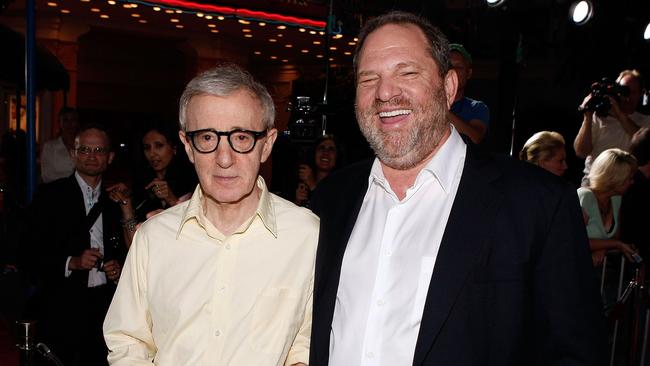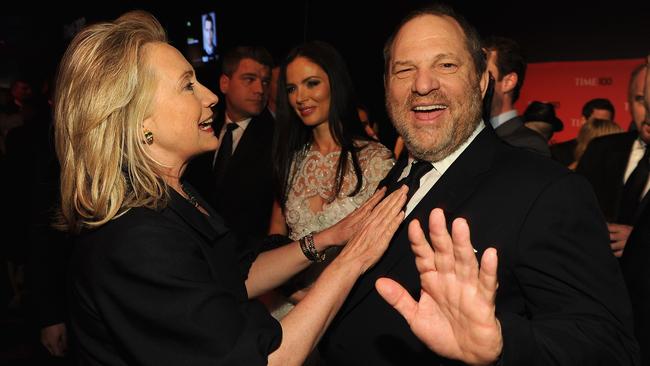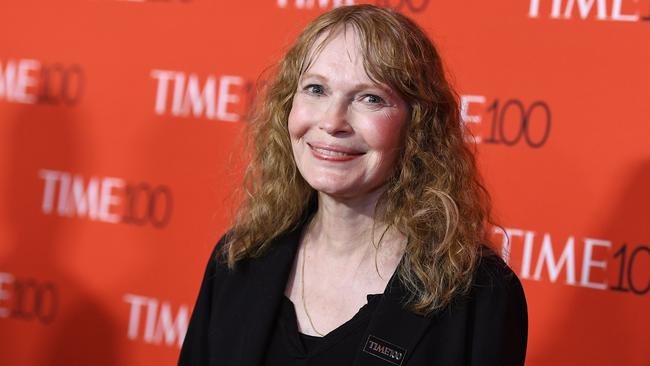Harvey Weinstein: Sex, lies and a network of silence
Ronan Farrow ran into obstacles at every step in seeking to expose alleged abuse by Harvey Weinstein.

Ronan Farrow had been working for months, chipping away at an explosive story about one of the most powerful figures in Hollywood, when he decided he needed insurance. Tired and paranoid, he was increasingly concerned that he was being followed. A friend had even suggested he get a gun.
So there he was, one New York summer, down in the basement of a bank, placing his material — an audio recording on a flash drive, transcripts of interviews, a list of sources — into a safe deposit box, along with a note on top.
“If you’re reading this,” he wrote, “it’s because I can’t make this information public myself. This is the blueprint to assembling a story that could bring a serial predator to justice.”
Two years ago this month, Farrow published the first of his reports on Harvey Weinstein, describing in damning detail how the veteran producer had sexually assaulted and harassed multiple women across many years. His account, in The New Yorker, came five days after two reporters at The New York Times, Jodi Kantor and Megan Twohey, broke open the story about Weinstein’s predatory behaviour and the settlements that concealed it. The three reporters later won a Pulitzer prize for public service journalism, with the citation saying their work had spurred “a worldwide reckoning about sexual abuse of women”.
“Weinstein was famous for his bullying, even threatening, style of doing business. He was deimatic, capable of expanding to frighten, like a blowfish inflating itself,” Farrow writes. “And then there were stories, mostly whispers, of a darker kind of violence against women, and of efforts to keep his victims quiet. Every few years, a reporter, alerted to the rumours, would sniff around, to see if the smoke might lead to fire.”
The broader Weinstein story is ultimately a story about power. It’s about the powerful individuals who prey on those around them as well as the forces that allow such behaviour to continue. Farrow’s pursuit of Weinstein brought the reporter into conflict with some of the most powerful figures in the US — as well as his own employer, NBC, as he details in a gripping new book about the saga.

Despite legal threats, hesitant witnesses and a counterintelligence operation worthy of John Le Carre, Farrow’s reporting made it out and “reverberated like a gunshot”.
“On one program after another, television personalities expressed disbelief,” Farrow writes. “What did it say about the gulf between the powerful and the powerless that wealthy individuals could intimidate, surveil, and conceal on such a vast scale?”
In Catch and Kill, released on Tuesday, Farrow details the considerable obstacles he faced while pursuing Weinstein: anxious senior management, aggressive lawyers, well-connected tabloid editors, undercover agents and a private intelligence company called Black Cube that was filled with former Mossad agents and recommended to Weinstein by none other than former Israel prime minister Ehud Barak. A film adaptation seems inevitable.
“Watch your back,” one producer said. “This guy, the people protecting him. They’ve got a lot at stake.”
One of the book’s most explosive revelations, leaked last week ahead of Tuesday’s publication date, centres on a rape allegation against Matt Lauer. The high-profile presenter, fired by NBC in November 2017 over a sexual misconduct claim, has responded by saying he was involved in a consensual affair and calling the allegation “categorically false”.
Farrow says the widespread use of non-disclosure agreements at NBC coincided with arguments from Weinstein that the agreements covering his own behaviour couldn’t be reported. Such revelations help explain why Farrow’s reporting ended up in The New Yorker rather than at NBC, where it began. The writer is withering about the corporate failures involved, the willingness to bow to threats and sit on allegations of sexual misconduct, as well as the culture of complicity that “swallowed women whole”. Weinstein, who denies non-consensual sex, is facing several charges including rape and sexual assault.
Catch and Kill takes its name from a tabloid practice where stories are bought, then buried. And it builds on another remarkable book, She Said, a behind-the-scenes account by Kantor and Twohey published last month.

In Catch and Kill, Farrow also makes allegations about the role of the National Enquirer — and its Australian editor-in-chief, Dylan Howard — in the Weinstein case as well as with stories involving Donald Trump and others. He claims the tabloid used various methods, including “catch and kill”, to protect Weinstein from scrutiny. (Howard’s lawyers reportedly have sent legal warnings to Australian bookshops and a publisher about Farrow’s book.) The Australian is not suggesting the allegations are true or that Howard engaged in any wrongdoing. In late 2016, according to Farrow, Howard forwarded to Weinstein a secret recording damaging to Rose McGowan, one of Weinstein’s accusers, describing the material as “something AMAZING”.
“This is the killer,” Weinstein replied. “Especially if my fingerprints r not on this.”
The role of Black Cube is also described in detail. Farrow was right to be concerned about being followed. His movements, online and off, are tracked constantly. Intelligence is also gathered about those involved in the story: accusers, sources, anyone connected to the reporters themselves.
It’s a shadowy world of espionage, double agents and misdirection. Internal documents are leaked to Farrow by a Black Cube source known only as Sleeper. “I’m an insider who is fed up with BC’s false and devious ways of obtaining material illegally,” Sleeper writes. “Moreover, in this case, I truly believe HW is a sex offender and I’m ashamed as a woman for participating.”

Farrow was an employee of NBC when he began reporting on Weinstein. But after months of research, during which time he had gathered a wealth of material, including on-the-record interviews, the network baulked. Weinstein, meanwhile, was lobbying executives at NBC, describing his behaviour to news boss Andy Lack as innocent indiscretions from another time: “It was the nineties, Andy. We all did that.”
On another occasion, Farrow, who has a considerably higher profile than most investigative journalists, finds himself at Time magazine’s annual gala dinner for its 100 most influential people. He was there with his mother, Mia Farrow. He bumps into Noah Oppenheim, one of his bosses at NBC, who mentions something interesting: “So Harvey’s here. He’s sitting with me at dinner.”
Later, Farrow’s bosses ask him to hit “pause”, then tell him to cease gathering material altogether. They encourage him to take his story elsewhere. He finds a willing audience at The New Yorker, where editor David Remnick says he will be defended “no matter how far Harvey Weinstein goes”.
There are many subplots that run throughout Catch and Kill, including the author’s relationship with Jon Lovett, a former speechwriter for Barack Obama.
Farrow’s life story is unavoidable, too. He recounts conversations with his sister, Dylan Farrow, who has accused their father, Woody Allen, of molesting her as a child. They discuss the Weinstein story and she gives advice.

After one frustrating encounter with a sceptical NBC executive, Farrow thinks back to an exchange with Dylan five years earlier, when she told the family she wanted to revive her allegations against Allen. “I don’t see why you can’t just move on,” Farrow said at the time.
“You had that choice,” she replied. “I didn’t.”
Weinstein uses all this against Farrow. He tells an NBC boss that the reporter had a “huge conflict of interest” because the producer had distributed Allen’s movies in the 1990s.
Farrow, who had gone public in support of his sister, is open about his personal involvement. In response to learning, for instance, that one member of Weinstein’s legal team, Elkan Abramowitz, had defended their father against his sister, Farrow says this made his feelings less personal, not more. “This wasn’t about any one victim; this, for Abramowitz and many other lawyers, was a cottage industry,” he says.
In one of the more eye-opening revelations in a book that has no shortage of them, Weinstein defends himself to Farrow directly. “You couldn’t save someone you love,” he said, “and now you think you can save everyone.”
“He really said this,” Farrow recalls. “You’d think he was pointing a detonator at Aquaman.”
Later, Weinstein’s legal team sent a letter to The New Yorker, calling the reporting defamatory and making much of the fact that NBC had declined to air Farrow’s story. “Mr Farrow is entitled to his private anger,” the letter said, raising concerns about the writer’s independence. The New Yorker described these concerns in return as being “without any merit whatsoever”, and the story went ahead.
Catch and Kill: Lies, Spies and a Conspiracy to Protect Predators is published in Australia today by Hachette Australia.
